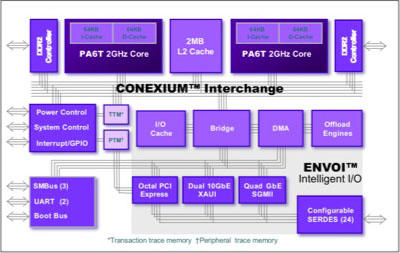 The new startup fabless semiconductor company P.A. Semi, today announced a new dual-core 64-bit PowerPC chip, to be released late next year. The 65 nm PA6T-1682M chip features dual 2 GHz 64-bit PowerPC cores with a shared 2 MB L2 cache, dual VMX units, dual DDR2 memory controllers, and several different I/O configurations. The chip apparently has not yet taped out, but is estimated to have per core SPECint performance of 1100 and per core SPECfp performance of 2255, all with a "typical" power usage of 13 Watts. While the SPECint performance is OK, it isn't great. However, if the chip were to live up to the hype and achieve the estimated 2255 score for floating point performance, that would be truly impressive, whether the score is peak or base, especially when the power utilization is considered.
The new startup fabless semiconductor company P.A. Semi, today announced a new dual-core 64-bit PowerPC chip, to be released late next year. The 65 nm PA6T-1682M chip features dual 2 GHz 64-bit PowerPC cores with a shared 2 MB L2 cache, dual VMX units, dual DDR2 memory controllers, and several different I/O configurations. The chip apparently has not yet taped out, but is estimated to have per core SPECint performance of 1100 and per core SPECfp performance of 2255, all with a "typical" power usage of 13 Watts. While the SPECint performance is OK, it isn't great. However, if the chip were to live up to the hype and achieve the estimated 2255 score for floating point performance, that would be truly impressive, whether the score is peak or base, especially when the power utilization is considered.
This is in stark contrast to Freescale's chips. The G4 currently also has reasonable integer and Altivec performance, but its floating point performance is poor. Freescale's next generation e600 line, due soon, will not significantly alter this situation since it essentially a tweaked dual-core version of the G4 in many ways. IBM's G5 provides floating point performance in spades, but IBM has not been able to provide a fast low power G5 option.
What does this all mean for Apple? Probably nothing, as Apple has already announced the switch to Intel. It should also be noted that P.A. Semi's chip will not ship for at least a year, and by that time Intel's dual-core 64-bit low power Merom should be available. Merom will provide vastly superior SPECint performance and at least reasonable SPECfp performance, albeit at higher power usage. It doesn't look like P.A. Semi's chips were ever in the cards for Apple. That would be fine for P.A. Semi however, since it seems that one of the main targets would be Freescale's embedded business, and they likely would not compete with the likes of Intel for the personal computer market. Another main target would be supercomputing clusters, where floating point performance and power efficiency are amongst the primary concerns.
Note again though that what we have here is still just prelimary information on a chip not due to sample for a year. However, P.A. Semi tomorrow will present the details of the chip at the Fall Processor Forum in San Jose. Hopefully we'll have a clearer idea of this chip's capabilities and its intended market tomorrow.
2 comments:
per core SPECfp performance of 2255
Ohmigod, is it a POWER5, an Itanium2, or a typo?!!!111ONEONE
I mean, 2255 per core????
:-)
I was surprised at that 2255 number too, and I am skeptical, but that's the number quoted by the Real World Technologies article.
Remember though that even if the numbers are anywhere close to being true, the chip is only sampling a year from now (assuming they can get it into production at 65 nm in a timely manner), and they've emphasized floating point performance at the expense of integer.
Hopefully P.A. Semi will confirm the performance estimates today.
Post a Comment